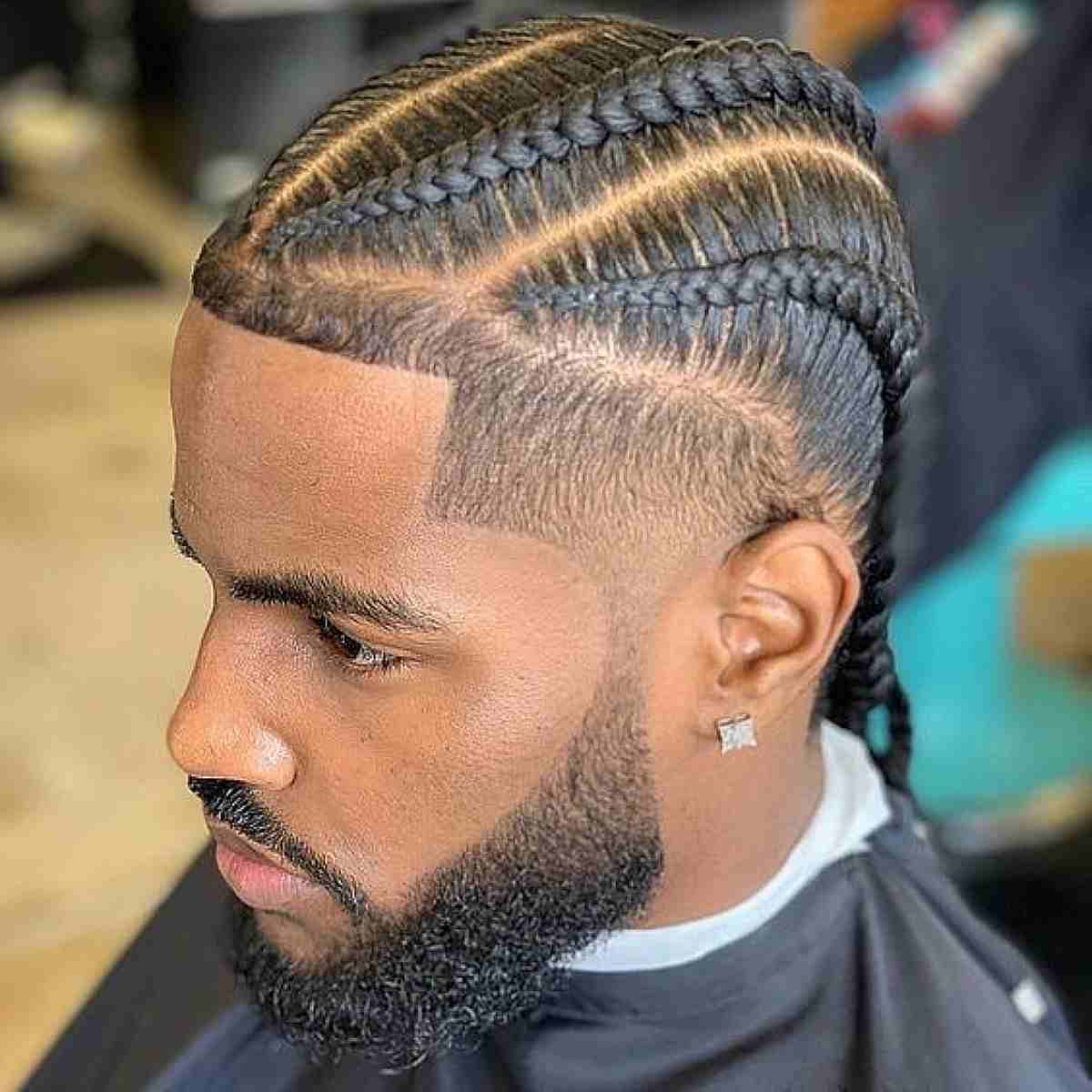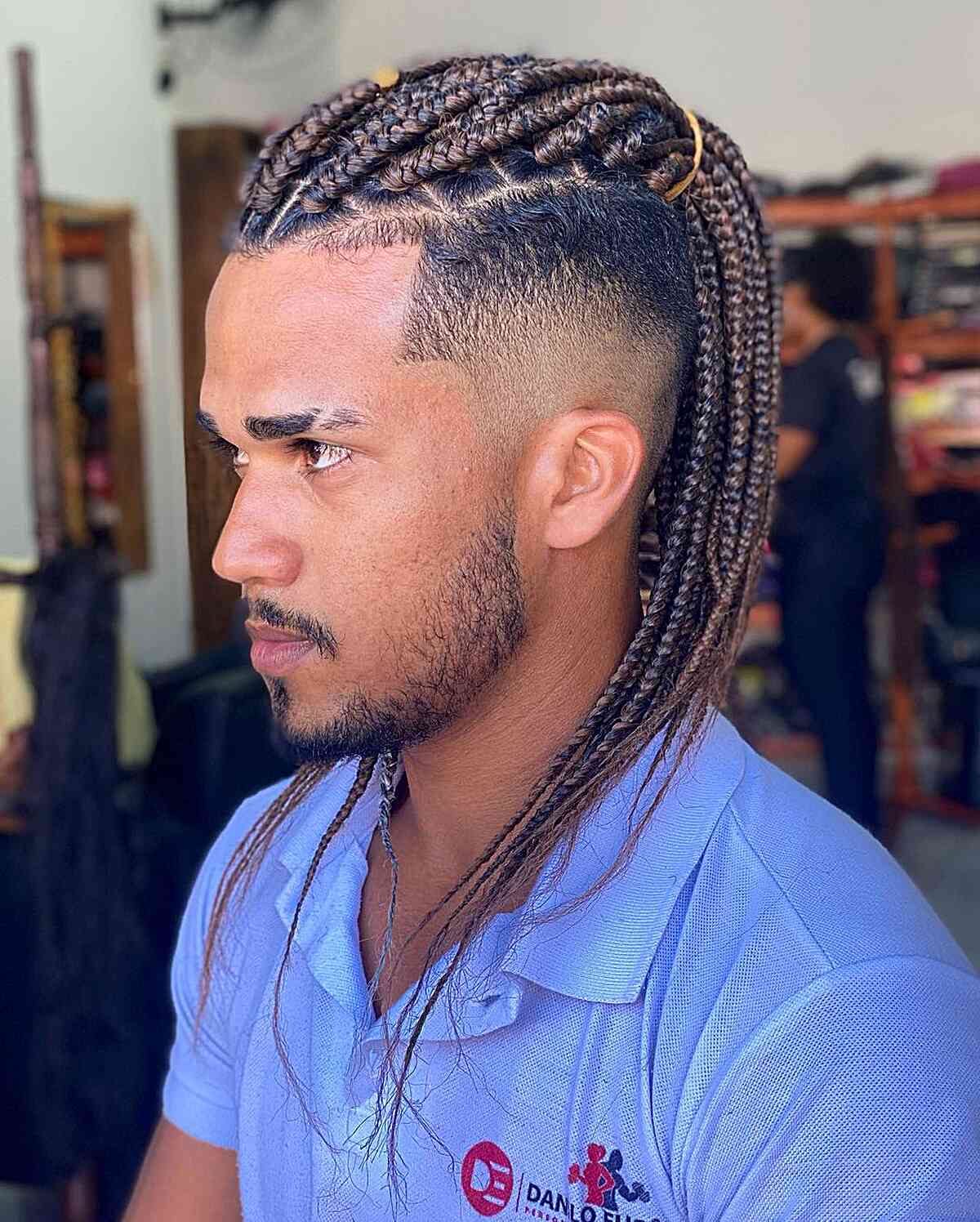For guys looking to refresh their appearance this season, learning about braiding men's short hair offers a truly cool way to stand out. There’s nothing more stylish and chic than a perfectly pleated braid, really. It gives your overall style a distinct edge, setting you apart from the usual haircuts you see around. This kind of hair design, you know, it just adds something special.
A nice braid, as a matter of fact, does more than just look good. It keeps your hair neatly out of your face, which is pretty handy for active days or just when you want a clean feel. Plus, it adds a fun "twist" to your everyday look, making your hair feel fresh and new without a big chop. It’s a simple change that makes a big impact, actually.
This article will explore how men with shorter hair can embrace this timeless technique. We will look at what makes braiding a good choice for guys, what hair length works best, and some popular designs you could try. Whether you are completely new to braiding or just want to brush up on some ideas, we have got you covered, you know.
Table of Contents
- Why Braid Short Hair?
- Is Your Hair Ready for Braids?
- Popular Short Braid Styles for Guys
- Getting Started: Tools and Prep
- Step-by-Step: The Basic Three-Strand Braid
- Tips for Braiding Shorter Hair
- Caring for Your Braids
- Finding a Braiding Specialist
- Frequently Asked Questions About Braiding Men's Short Hair
Why Braid Short Hair?
Braiding offers a cool mix of style and practicality, even for shorter hair. It is a way to express yourself without saying a word, really. This technique is one of the most versatile and timeless hairstyling methods, giving everything from simple everyday styles to intricate, elegant looks. For guys, it means a chance to experiment with their appearance, which is pretty neat.
Beyond just looking good, braids keep your hair neatly tucked away. This is super useful if you are active or just want to avoid hair falling into your eyes, so it is a functional choice. Plus, it adds a fun "twist" to your everyday look, giving your style a bit of personality. It is a nice way to change things up, you know, without a lot of fuss.
Historically, people have worn braided hairstyles for thousands of years all over the world. This shows how enduring and widely loved the style is, in some respects. The style is one of the most versatile, running from incredibly intricate patterns to simple plaits. This long history means it is always in style, and it always looks good, too it's almost a classic.
Is Your Hair Ready for Braids?
A common question is whether short hair can actually be braided. The good news is, yes, it often can be, though the length does matter a bit. Generally speaking, you will need at least two to four inches of hair to get a good hold and create a visible braid. Shorter than that, and it might be a bit tricky to keep the strands together, you know.
For some styles, like cornrows, you might get away with slightly less length, especially if a professional is doing it. They have ways to work with shorter strands, apparently. However, for styles that hang freely, like individual box braids, having a bit more length gives a better result. It just makes the process smoother and the braids hold better, too.
Think about the texture of your hair as well. Hair that is naturally curly or coily tends to hold braids better, as it has more grip. Straighter hair can be braided, but it might need a bit more product or a tighter technique to stay put. This is something to keep in mind, you know, as you plan your look.
Popular Short Braid Styles for Guys
Even with shorter hair, there are many cool braided styles to pick from. The style is one of the most versatile, offering a lot of options. From simple designs to more complex ones, you can find something that fits your personal taste and hair length, which is pretty exciting.
Cornrows for Shorter Hair
Cornrows are a very popular choice for men with shorter hair, and for good reason. They lie flat against the scalp, making them a neat and practical style. You can create various patterns with cornrows, from straight lines to more curved or zig-zag designs, so there is a lot of room for creativity.
For shorter hair, smaller cornrows or those that start closer to the hairline tend to work best. They require less length to secure properly, which is helpful. A good braider can often work wonders with just a few inches of hair, making sure the braids look sharp and last well, too.
These braids are great for keeping hair out of the way during sports or just for a clean, put-together look. They are also pretty low maintenance once they are in, which many guys appreciate. You can just get up and go, you know, which is a big plus.
Box Braids on Shorter Hair
While often seen on longer hair, box braids can also work for shorter lengths, especially if you use extensions. Braids can be made from existing hair only or can include extensions and accessories. This means you can get the look of longer braids even if your own hair is not quite there yet.
For shorter hair, smaller box braids or those that start closer to the scalp are usually better. They put less strain on your natural hair and can be easier to manage. If you are adding extensions, make sure they are not too heavy for your hair, as a matter of fact, to avoid any pulling.
Box braids offer a lot of versatility in styling once they are in. You can tie them up, let them hang, or even combine them with other styles. They are a really cool option for changing your look, and they last a while, too.
Simple Plaits and French Braids
If you are just starting out with braiding men's short hair, a simple three-strand plait or a basic French braid can be a great place to begin. Everyone has to start somewhere, and the three-strand braid is the ultimate first step. These styles are easier to learn and practice on your own hair, or on a friend's, you know.
A simple plait involves dividing a section of hair into three parts and crossing them over each other. It is a foundational skill for all other braids, so it is good to get this down. French braids are similar but involve adding small sections of hair as you go, creating a braid that lies flat against the head, which is pretty neat.
These simpler styles are perfect for a casual look or for managing hair that is growing out. They are quick to do once you get the hang of them and offer a clean, stylish appearance. You might be surprised how much difference a simple braid can make, actually.
Getting Started: Tools and Prep
Before you start braiding, having the right tools and getting your hair ready makes a big difference. You do not need a lot, but a few key items will help the process go smoothly. This is pretty important for a good outcome, you know.
First, make sure your hair is clean and well-conditioned. This makes it easier to work with and helps prevent tangles. A leave-in conditioner or a light hair oil can also add moisture and make the hair more pliable. This step is pretty crucial for managing shorter strands, too.
You will want a fine-tooth comb for sectioning your hair precisely. Good sections are key to neat braids, especially when your hair is short. Hair clips or ties are also handy for holding sections of hair out of the way while you work on others, so you can focus on one part at a time.
Finally, a good quality hair gel or pomade can help keep stray hairs in place and give your braids a polished finish. For shorter hair, a product with good hold is often necessary to prevent strands from popping out. Just a little bit can make a big difference, honestly.
Step-by-Step: The Basic Three-Strand Braid
Learning the basic three-strand braid is a fundamental skill for anyone interested in braiding men's short hair. It is the building block for almost every other braid style, so getting this down is a great start. This is how you begin, you know.
First, take a section of hair where you want your braid to be. For shorter hair, start with a smaller section, perhaps at the top or side of your head. Use your comb to make a clean, straight part, which is pretty important for a tidy look.
Next, divide this section of hair into three equal parts. You will want to hold these parts firmly but gently between your fingers. This is where the practice comes in, as a matter of fact, to keep them separate but easy to move.
Now, cross the right strand over the middle strand. The right strand will now become the new middle strand. Then, cross the left strand over what is now the middle strand. This left strand becomes the new middle, and you just keep repeating this pattern, so it is a simple rhythm.
Continue this process, crossing the outer strands over the middle one, working your way down the length of the hair. Keep your tension even to create a consistent braid. For short hair, you might only get a few crosses before you run out of length, but that is perfectly fine. Secure the end with a small elastic band, and you are done, you know.
Tips for Braiding Shorter Hair
Braiding shorter hair can present its own set of little challenges, but with a few pointers, you can make it much easier. These ideas can help you get a better result, you know, and make the process less frustrating.
- Start Small: When practicing, begin with very small sections of hair. This allows you to focus on the technique without getting overwhelmed by too much hair. It is easier to control, too.
- Use Product: A light pomade, gel, or braiding cream can provide extra grip and help keep those shorter strands from slipping out. Apply just a little bit to your fingers or directly to the hair before you start.
- Keep Tension Even: Maintaining consistent tension is key for neat braids, especially with short hair. If your tension is too loose, the braid might fall apart. If it is too tight, it could pull on your scalp, so it is a balance.
- Work with Damp Hair: Slightly damp hair can be easier to braid than completely dry hair. It is more pliable and less likely to frizz. Just make sure it is not soaking wet, as that can be harder to manage, too.
- Practice, Practice, Practice: Braiding is a skill that gets better with repetition. Do not get discouraged if your first few attempts are not perfect. Keep trying, and you will see improvement, honestly.
- Consider a Mirror: Using a handheld mirror along with a wall mirror can help you see the back of your head more clearly, which is pretty helpful when working on those harder-to-reach spots, you know.
Caring for Your Braids
Once you have your braids in, whether you did them yourself or had a professional do them, proper care helps them last longer and keeps your scalp healthy. Good care is pretty important for keeping your look fresh, you know.
Keeping your scalp clean is a big part of braid care. You can use a diluted shampoo or a braid spray to cleanse your scalp without messing up the braids too much. Experts tell the truth about washing your synthetic braiding hair, how to do it, and if it really works. Even with natural hair braids, a gentle cleanse is good, as a matter of fact.
Moisturizing your scalp and hair is also important. Use a light oil or leave-in conditioner to prevent dryness and itching. Apply it directly to your scalp between the braids, which is pretty effective. This helps keep your hair healthy underneath the braids, too.
To protect your braids while you sleep, wrap your head with a silk or satin scarf, or use a satin pillowcase. This reduces friction and helps prevent frizz and loosening of the braids. It just keeps them looking good for longer, so it is a simple step with big benefits.
Do not keep your braids in for too long, especially if your hair is short. A few weeks is usually a good time frame before you should take them out, wash your hair thoroughly, and give your scalp a break. This helps prevent damage to your natural hair, which is pretty important, you know.
Finding a Braiding Specialist
If doing your own braids feels like a bit too much, or if you want a more intricate style, finding a professional braider is a great idea. They have the skill and experience to create amazing looks, even on shorter hair. They can do some really cool things, you know.
Look for salons that specialize in various braiding techniques. For example, places that offer the best hair braiding for box braids, knotless braids, micro braids, cornrows, and much more, are usually a good bet. They will have experience with different hair types and lengths, which is pretty important.
A place like Blue Nile Hair Braiding Salon, situated in the vibrant Midway area of Saint Paul, is an example of a place that might have the expertise you need. Seeking out specialists in your local area can ensure you get a high-quality, long-lasting braid. It is worth doing a little research to find someone good, honestly.
When you visit a braider, talk to them about your hair length and the style you want. They can advise you on what will work best for your specific hair type and length. A good consultation is key to getting the look you want, you know, and making sure it is something you will love.
Frequently Asked Questions About Braiding Men's Short Hair
Many guys have questions when they first consider braiding men's short hair. Here are some common inquiries and their answers, just to help clear things up.
Can short hair be braided?
Yes, short hair can absolutely be braided. You typically need at least two to four inches of hair length for most braid styles to hold well. Some styles, like cornrows, might work with slightly less. The key is often the texture of your hair and the skill of the braider, so it is definitely possible.
What length hair is needed for braids male?
For men, a minimum of about two inches is generally needed for simple braids or cornrows. For styles like individual box braids that hang more freely, three to four inches or more is often better. If you are planning to add extensions, the natural hair just needs enough length to be gripped and secured, which is usually around two inches, you know.
How do you braid short hair for men?
Braiding short hair for men starts with clean, slightly damp hair and good sectioning. For a basic three-strand braid, you divide a small section into three parts and cross the outer strands over the middle one, working down. For cornrows, you pick up small sections of hair as you braid, keeping the braid close to the scalp. Using a bit of product helps keep stray hairs in place, too, which is pretty helpful.
Learning about braiding men's short hair truly opens up new possibilities for personal style. Not only does a nice braid keep your hair out of your face, but it also adds a fun "twist" to your everyday look, as a matter of fact. It's a simple change that can refresh your entire appearance. For more insights on hair care and styling, you can learn more about hair trends on our site, and also check out this page for more styling tips. You might also find useful information on hair product choices at a good hair care resource, which is pretty helpful for keeping your hair in top shape. It is all about finding what works for you, you know, and having some fun with your look.



